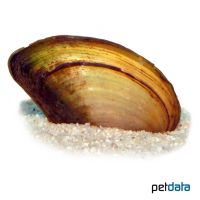Swan Mussel (Anodonta cygnea)
| Swan Mussel Anodonta cygnea | |
|---|---|
| Name | Swan Mussel |
| Name Lat. | Anodonta cygnea |
| Family | Unionids |
| Family lat. | Unionidae |
| Order | Unionoida |
| Order lat. | Unionoida |
| Origin | Europe |
| Habitat | Streams, lakes, pools |
| Diet | Planktivore |
| pH | 7.0-8.0 |
| Behavior | Peaceful |
| Keeping | Individual, group |
| Care Level | Moderate |
| Reproduction | Oviparous |
| Breeding | Difficult |
| Life Span | 10-15 years |
| Protection | No |
| Metric Units | |
| Size | 20 cm |
| Temperature | 3-27 °C |
| Hardness | 5-15 °dH |
| Aquarium | Ponds |
| US Units | |
| Size | 7.9" |
| Temperature | 37-81 °F |
| Hardness | 89-267 ppm |
| Aquarium | Ponds |
Distribution and habitat
The pond mussel is widespread in northern and central Europe, throughout the Danube region and from the Balkans to the Caucasus. They occur in clean, often plant-rich stagnant waters, such as lakes and ponds, but also in oxbows and bays of slow-flowing waters, where they sometimes live burrowed on the bottom.
Maintenance
The pond should be furnished with pond, floating and oxygenating underwater plants (milfoil, waterweed, hornwort, etc.), large river pebbles, and a graveable substrate of round-grained gravel and sand.
When maintaining in a cold water aquarium (100 l or more), make sure that there is plenty of free bottom space available in addition to border planting, with a graveable bottom substrate of sand and gravel about 20 cm deep
No ammonia, ammonium and nitrite should be detectable in the water and the nitrate value should be below 100 mg/l. When using a filter, make sure that only a weak current is created and that not too many suspended particles are filtered out of the water, as these serve as food for them.
Diet
The pond mussels are filter feeders, feeding on phyto- and zooplankton, detritus and other suspended matter. It stirs up the bottom substrate somewhat with its foot and swirls in the water. The food is filtered out of the water through the gills and passed on to the mouth opening. When keeping in an aquarium, fine dust food, spirulina powder and commercially available plankton food for filter feeders should also be fed.
Behaviour and compatibility
The pond mussels are completely peaceful and can be socialized with fish, snails and crayfish without any problems. Especially suitable are, for example, bitterlings, which can reproduce only with the help of pond mussels. Caution is advised with large crayfish, which can open and eat pond mussels. In principle, only mutually compatible species with similar requirements for water quality and water temperature should be socialized.
Reproduction and breeding
The pond mussels are hermaphrodites. The eggs are fertilized in the gills of the mussel and cared for over the winter in the crevices between the gills (long brooders). In spring, 200,000 to 600,000 mussel larvae are gradually expelled with adhesive filaments called glochidia. The glochidia usually attach themselves to the fin skin of passing fish and settle. There, the larvae develop as parasites on the fish to form small shells and are shed or detach themselves after 2-8 weeks. Larvae that do not find a host fish die.
The pond mussel can live up to 15 years.
Species protection
The native pond mussel is specially protected according to the Federal Species Protection Ordinance (BArtSchV). The proof of purchase is the required proof of origin for the animal. Please keep it well!
Your pet store will be happy to provide you with further information.
Important
A pond mussel can filter up to 1,000 liters of water per day and thus contribute to water purification. It can move slowly by stretching its foot forward and then dragging its body. When feeding, their shells are only slightly open. Dead pond mussels can be recognized by their wide open shells
If there are too many pond mussels in a pond, the glochidia can become a problem for the fish. Especially for small and young fish the mass infestation can lead to death.
If pond mussels are overwintered in the pond, sufficient depth and oxygen supply (filter, oxygen dispenser, ice free holder) must be ensured.
Regular partial water changes are recommended, even if the pollutant load has not yet reached the upper limit. Sudden changes in water quality should be avoided. Newly introduced animals must be accustomed slowly to the water in the aquarium or pond.
Further literature can be found in your pet store.
References
Text: Barbara Pachner; Image: petdata
Source: BITTER (2008): Schnecken-Fibel, Dähne Verlag; ENGELMANN & LANGE (2011): Zootierhaltung - Tiere in menschlicher Obhut: Wirbellose, Verlag Harri Deutsch
